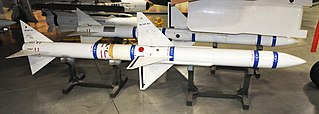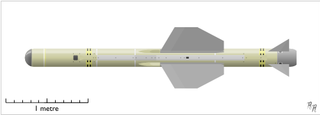Related Research Articles

The AIM-7 Sparrow is an American medium-range semi-active radar homing air-to-air missile operated by the United States Air Force, United States Navy, United States Marine Corps, and various other air forces and navies. Sparrow and its derivatives were the West's principal beyond visual range (BVR) air-to-air missile from the late 1950s until the 1990s. It remains in service, although it is being phased out in aviation applications in favor of the more advanced AIM-120 AMRAAM.

The AIM-54 Phoenix is an American radar-guided, long-range air-to-air missile (AAM), carried in clusters of up to six missiles on the Grumman F-14 Tomcat, its only operational launch platform.

A missile is an airborne ranged weapon capable of self-propelled flight aided usually by a propellant, jet engine or rocket motor. Historically, 'missile' referred to any projectile that is thrown, shot or propelled towards a target; this usage is still recognized today with any unguided jet- or rocket-propelled weapons generally described as rocket artillery. Airborne explosive devices without propulsion are referred to as shells if fired by an artillery piece and bombs if dropped by an aircraft.

A surface-to-air missile (SAM), also known as a ground-to-air missile (GTAM) or surface-to-air guided weapon (SAGW), is a missile designed to be launched from the ground to destroy aircraft or other missiles. It is one type of anti-aircraft system; in modern armed forces, missiles have replaced most other forms of dedicated anti-aircraft weapons, with anti-aircraft guns pushed into specialized roles.

The RIM-7 Sea Sparrow is a U.S. ship-borne short-range anti-aircraft and anti-missile weapon system, primarily intended for defense against anti-ship missiles. The system was developed in the early 1960s from the AIM-7 Sparrow air-to-air missile as a lightweight "point-defense" weapon that could be retrofitted to existing ships as quickly as possible, often in place of existing gun-based anti-aircraft weapons. In this incarnation, it was a very simple system guided by a manually aimed radar illuminator.

The Bristol Bloodhound is a British ramjet powered surface-to-air missile developed during the 1950s. It served as the UK's main air defence weapon into the 1990s and was in large-scale service with the Royal Air Force (RAF) and the forces of four other countries.
Fairey's Green Cheese, a rainbow code name, was a British-made radar-guided anti-ship missile project of the 1950s. It was a development of the earlier and much larger Blue Boar television guided glide bomb, making it smaller, replacing the television camera with the radar seeker from the Red Dean air-to-air missile, and carrying a smaller warhead of 1,700 pounds (770 kg).
Blue Water was a British battlefield nuclear missile of the early 1960s, intended to replace the MGM-5 Corporal, which was becoming obsolete. With roughly the same role and range as Corporal, the solid-fuel Blue Water was far simpler to use and would be significantly easier to support in the field. It was seen as a replacement for Corporal both in the UK as well as other NATO operators, notably Germany and possibly Turkey.

Fireflash was the United Kingdom's first air-to-air guided missile to see service with the Royal Air Force. Constructed by Fairey Aviation, the missile utilised radar beam riding guidance. Fireflash had relatively limited performance and required the launching aircraft to approach the target from a limited angle astern.

The de Havilland Firestreak is a British first-generation, passive infrared homing air-to-air missile. It was developed by de Havilland Propellers in the early 1950s, entering service in 1957. It was the first such weapon to enter active service with the Royal Air Force (RAF) and Fleet Air Arm, equipping the English Electric Lightning, de Havilland Sea Vixen and Gloster Javelin. It was a rear-aspect, fire and forget pursuit weapon, with a field of attack of 20 degrees either side of the target.

The Hawker Siddeley Red Top was the third indigenous British air-to-air missile to enter service, following the de Havilland Firestreak and limited-service Fireflash. It was used to replace the Firestreak on the de Havilland Sea Vixen and later models of the English Electric Lightning.

The English Electric Thunderbird was a British surface-to-air missile produced for the British Army. Thunderbird was primarily intended to attack higher altitude targets at ranges up to approximately 30 miles (48 km), providing wide-area air defence for the Army in the field. anti-aircraft guns were still used for lower altitude threats. Thunderbird entered service in 1959 and underwent a major mid-life upgrade to Thunderbird 2 in 1966, before being slowly phased out by 1977. Ex-Army Thunderbirds were also operated by the Royal Saudi Air Force after 1967.

Red Dean, a rainbow code name, was a large air-to-air missile developed for the Royal Air Force during the 1950s. Originally planned to use an active radar seeker to offer all-aspect performance and true fire-and-forget engagements, the valve-based electronics demanded a missile of prodigious size.

A precision-guided munition is a guided munition intended to precisely hit a specific target, to minimize collateral damage and increase lethality against intended targets. During the First Gulf War guided munitions accounted for only 9% of weapons fired, but accounted for 75% of all successful hits. Despite guided weapons generally being used on more difficult targets, they were still 35 times more likely to destroy their targets per weapon dropped.

The Short Range Air-to-Air Missile, or SRAAM for short, initially known as Taildog, was an experimental British infrared homing air-to-air missile, developed between 1968 and 1980 by Hawker Siddeley Dynamics. It was designed to be very manoeuvrable for use at short range in a dogfight situation. SRAAM was unusual in that it was launched from a launch tube instead of being attached to a launch rail, allowing two to be carried on a single mounting point.
Brakemine was an early surface-to-air missile (SAM) development project carried out in the United Kingdom during World War II. Brakemine used a beam riding guidance system developed at A.C. Cossor, while REME designed the testbed airframes. Trial launches were carried out between 1944 and 1945, and the effort wound down as the war ended. Although Brakemine would never be used in its original form, its use of the "twist-and-steer" guidance method would later be used on the more capable LOPGAP design, which, after major changes, emerged as the Bristol Bloodhound. A single Brakemine survives in the REME Museum.
Blue Envoy was a British project to develop a ramjet-powered surface-to-air missile. It was tasked with countering supersonic bomber aircraft launching stand-off missiles, and thus had to have very long range and high-speed capabilities. The final design was expected to fly at Mach 3 with a maximum range of over 200 miles (320 km).
Artemis, named for the Greek goddess of the hunt, was an early air-to-air missile project carried out by the Royal Aircraft Establishment (RAE) beginning in late 1943. The missile was intended for radar-equipped night fighters like the Bristol Beaufighter, which would track the target on their AI Mk. IV radar and then fire at a set range, with the missile homing on the signal of the AI radar being reflected off the target.
Red Hebe was a large active radar homing air-to-air missile developed by Vickers for the Royal Air Force's Operational Requirement F.155 interceptor aircraft. It was a development of the earlier Red Dean, which was not suitable for launch by the new supersonic aircraft. Before progressing much beyond advanced design studies, F.155 was cancelled in the aftermath of the 1957 Defence White Paper which moved Britain's attention from strategic bombers to ballistic missiles. With no other suitable platform, Red Hebe was cancelled as well.

The 2-inch RP, short for Rocket Projectile, 2-inch, Number 1 Mark 1, was an unguided rocket weapon developed by the Royal Navy in the 1950s. It is generally similar to contemporary rockets like the SNEB and FFAR, although somewhat smaller. It is sometimes known as the RP-2 or RN, but most often referred to simply as the 2-inch.
References
Citation
- 1 2 3 4 Gibson & Buttler 2007, p. 11.
- 1 2 3 4 Gibson & Buttler 2007, p. 28.
Bibliography
- Gibson, Chris; Buttler, Tony (2007). British Secret Projects; Hypersonics, Ramjets and Missiles. Midland Publishing. ISBN 9781857802580.